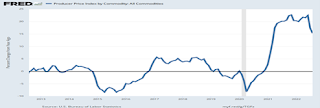What is worse, inflation rates, say, of 4 to 5 percent—slightly above historical averages, and average gas prices maybe $3.50 per gallon as they are today—or raising short term rates enough to make consumers pay more and job losses mount?
That is essentially the devil’s bargain the Fed seems to be offering Americans by Fed Chair Powell insisting that, “Reducing inflation is likely to require a sustained period of below-trend growth,” in his speech to the central bankers and economists gathered at the base of the Grand Tetons.
As financial markets continue to plunge on fears that the Fed will slow down growth so much that it will induce a recession, economists such as Nobel Prize-winner Joseph Stiglitz are warning the Fed may go too far.
“Monetary policy typically affects economic performance with long and variable lags, especially in times of upheaval,” said Professor Stiglitz in a recent Project Syndicate article. “Given the depth of geopolitical, financial, and economic uncertainty – not least about the future course of inflation – the Fed would be wise to pause its rate hikes and wait until a more reliable assessment of the situation is possible.”
“There are several reasons to hold off," continues Stiglitz. "The first is simply that inflation has slowed sharply. Consumer price index (CPI) inflation – the measure most relevant to households – was zero in July, and it is likely to have been zero or even negative in August (was 0.1%). Similarly, the personal consumption expenditure (PCE) deflator – another often-used measure based on GDP accounts – fell by 0.1% in July.”
So, the Fed may be looking in the wrong direction (the 1970s) for the causes of inflation. Wages, which were considered the main culprit for rising prices in the 70s, aren’t rising as they did then; have in fact fallen 2.8 percent behind the latest inflation surge.
Why not look at the much more severe and temporary supply-chain disruptions; the Ukraine war, and China’s COVID lockdowns as the major cause for the inflation spike?
Wholesales prices are falling even faster—with the Producer Price Index (PPI) down -0.1 percent in August reported today. The increase in the core prices without the volatile food and energy prices over the past year also slowed to 5.6 percent from 5.8 percent.
It makes more sense that markets should wait for the PPI index to come out before passing judgement on the Consumer Price Index, since the PPI ingredients (such as raw material prices) will tell us how retail (CPI) prices are trending. But, no, financial markets work on the hair-trigger principle, are too impatient in the one-click digital markets with their herd mentality to wait another day for the PPI results.
Counterbalancing rising inflation is also the super-strong Dollar making import prices cheaper for consumers and industrial materials. The dollar index, which tracks the greenback against its peers, was up 1.5 percent at 109.85 in its biggest one-day percentage gain since March 2020 after the CPI report.
Market traders and even retail players in financial markets have to be experiencing whiplash with Fed Governors continually pronouncing their take on current inflation conditions.
Yesterday’s 1200-point drop in the DOW and 100 plus point drop in the S&P indexes should be a lesson for traders to take their finger off the trigger more often and not keep firing indiscriminately at such a moving target as U.S. stock and bond prices.
It’s difficult to steer in the right direction when eyes are focused on the rear view mirror and stagflation fears of another era.
Harlan Green © 2022
Follow Harlan Green on Twitter: https://twitter.com/HarlanGreen


No comments:
Post a Comment